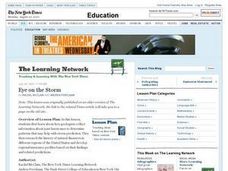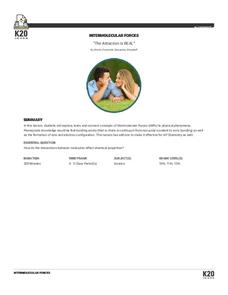Curated OER
Biology Project: Gone Fishing
Students write a scientific article using data and prediction skills. In this scientific writing lesson, students access data about fishing off the coast of New Jersey. They look at satellite data, fluorometry and CTD data over a 3 -4...
Curated OER
Eye on the Storm
Young scholars discover the way geologists collect information about past hurricanes to determine patterns that may help with storm prediction. They then research the history of natural disasters in different regions of the United States...
Curated OER
Wether Prediction
Students participate in a online weather course. They accurately forecast the weather and work through a series of four lessons. In addition, they present a weather forecast in front of the class, just like the weather people on...
Curated OER
Gravity and Falling Objects
Students watch experiments to define gravity and what gravity's function. In this gravity lesson plan, students watch video segments about experiments conducted with two objects to see what gravity does with different masses.
Teach Engineering
Magnetic or Not?
The class must determine the magnetic properties of different materials, including aluminum and steel by sorting through materials using a magnet. Groups make a prediction on whether a material is magnetic and then perform tests to...
Curated OER
The Scientific Method, Blood Typing, and Antibiotic Resistance
Students are given some components of an experiment, where they are able to identify and fill in missing parts, such as hypothesis, conclusion, results, etc. They form a hypothesis given general scientific facts. Students apply the...
Radford University
A Change in the Weather
Explore the power of mathematics through this two-week statistics unit. Pupils learn about several climate-related issues and complete surveys that communicate their perceptions. They graph both univariate and bivariate data and use...
Curated OER
Water Cycle
Identify and interpret the earth's different water sources. Third and fourth graders describe and demonstrate the process of the water cycle, make a model of its two main parts, and predict and infer to answer questions about the model.
Teach Engineering
Earthquakes Living Lab: Locating Earthquakes
There are patterns in nearly everything — even earthquakes. Pairs research current earthquakes to see if there are any patterns. They determine the mean, median, and mode of the earthquake data, along with the maximum and minimum. Using...
Curated OER
Science: Let's Investigate!
This presentation on the scientific method uses simple terms for young learners. It will elicit a lot of discussion in your class as they figure out what the people in the slides are trying to discover. Very nice!
Berkshire Museum
Adopt a Schoolyard Tree
Help young scientists connect with nature and learn about trees with a fun life science lesson. Heading out into the school yard, children choose a tree to adopt, taking measurements, writing descriptions, and drawing sketches of it in...
LABScI
Surface Tension: Liquids Stick Together
Use science to help you walk on water! Young scientists explore the properties of liquids including cohesion, adhesion, and surface tension. They use graphs to compare different liquids and make predictions about their molecular attraction.
National Wildlife Federation
At-Risk Species
Certain behaviors make species vulnerable to extinction and others protect them. By studying species that are currently endangered, learners draw conclusions about these behaviors. They then apply their conclusions to healthy species and...
K20 LEARN
The Attraction is REAL
How attractive is your intermolecular forces lesson plan? Draw your class in with an activity that includes research, presentation, and demonstrations. Chemistry scholars work together to create claims about the each intermolecular...
Curated OER
Hazards of Defrosted Food
Peas spoilage hot, peas spoilage cold: examine the bacterial growth on newly defrosted peas versus peas that have been defrosted for 24 hours. Using the session one questions in the "Microbes and Food Spoilage" PDF, learners will make...
Howard Hughes Medical Institute
Color Variation Over Time in Rock Pocket Mouse Populations
While many mutations are neutral, those that appear advantageous increase in frequency in a population. Scholars use illustrations to make predictions about populations of mice. They follow it up with a video to confirm or refute their...
NASA
Future Temperature Projections
No one knows what the future will bring, but it's likely to be warmer than before. Pupils first learn about the NASA GISS ModelE2, a global climate model, and about representative concentration pathways that estimate the global output of...
Pingry School
Determination of the Molar Mass of an Unknown Acid
Acids and bases have a love-hate relationship. They balance each other so nicely, but they are complete opposites! Learners use these concepts and titration to calculate the molar mass of an unknown substance. The experiment document...
Pingry School
Precipitation Reactions and General Solubility Rules
The more you know, the better your predictions! Using a hands-on lab experiment, collaborative groups collect information about ionic interactions. They record data describing the precipitate of reactions and use their information to...
McGraw Hill
Gravitational Lensing Interactive
Investigate light in space as it encounters a large mass of matter. Learners discover the idea of gravitational lensing through an interactive activity. They adjust the size and location of the mass to see the effect on the path of...
LABScI
Stoichiometry: Baking Soda and Vinegar Reactions
Examine the concept of stoichiometry using common household products. Scholars perform chemical reactions and measure the reactants and products. They compare their measurements to predictions made from the chemical equations.
Serendip
Genetics Review Jeopardy Game
Why not add a little excitement to review day? Play genetic Jeopardy to quiz your classes before they take the assessment. The resource provides a game board in PowerPoint with questions related to meiosis and prediction of traits.
Curated OER
Student Designed Investigations Part 2 – Testable Questions, Predictions, Materials and Procedures
Students create their own investigations. For this science experiments lesson, students use the steps of the scientific method to design an investigation. Students share their findings on a poster.
Curated OER
Weather Maps and Prediction
Second graders point out symbols for high and low pressure that would be found on weather maps. They break into small groups and use a copy of the weather maps file to make observations about the maps and come up with an explanation of...

























